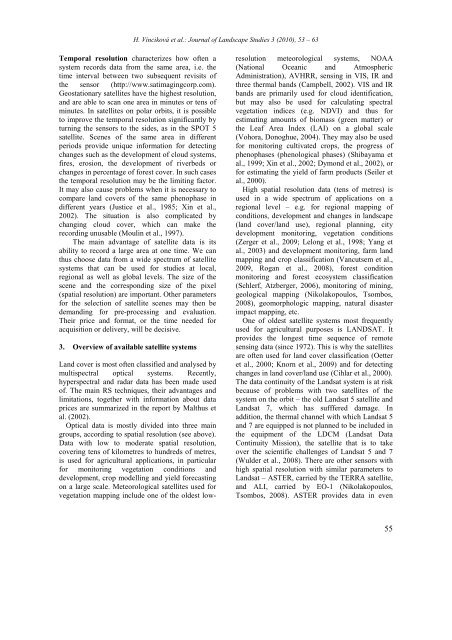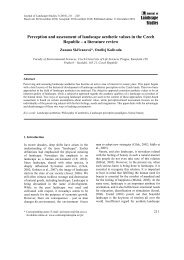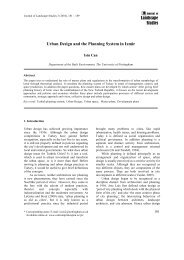Landscape Studies Use of remote sensing methods in studying ...
Landscape Studies Use of remote sensing methods in studying ...
Landscape Studies Use of remote sensing methods in studying ...
You also want an ePaper? Increase the reach of your titles
YUMPU automatically turns print PDFs into web optimized ePapers that Google loves.
H. V<strong>in</strong>ciková et al.: Journal <strong>of</strong> <strong>Landscape</strong> <strong>Studies</strong> 3 (2010), 53 – 63<br />
Temporal resolution characterizes how <strong>of</strong>ten a<br />
system records data from the same area, i.e. the<br />
time <strong>in</strong>terval between two subsequent revisits <strong>of</strong><br />
the sensor (http://www.satimag<strong>in</strong>gcorp.com).<br />
Geostationary satellites have the highest resolution,<br />
and are able to scan one area <strong>in</strong> m<strong>in</strong>utes or tens <strong>of</strong><br />
m<strong>in</strong>utes. In satellites on polar orbits, it is possible<br />
to improve the temporal resolution significantly by<br />
turn<strong>in</strong>g the sensors to the sides, as <strong>in</strong> the SPOT 5<br />
satellite. Scenes <strong>of</strong> the same area <strong>in</strong> different<br />
periods provide unique <strong>in</strong>formation for detect<strong>in</strong>g<br />
changes such as the development <strong>of</strong> cloud systems,<br />
fires, erosion, the development <strong>of</strong> riverbeds or<br />
changes <strong>in</strong> percentage <strong>of</strong> forest cover. In such cases<br />
the temporal resolution may be the limit<strong>in</strong>g factor.<br />
It may also cause problems when it is necessary to<br />
compare land covers <strong>of</strong> the same phenophase <strong>in</strong><br />
different years (Justice et al., 1985; X<strong>in</strong> et al.,<br />
2002). The situation is also complicated by<br />
chang<strong>in</strong>g cloud cover, which can make the<br />
record<strong>in</strong>g unusable (Moul<strong>in</strong> et al., 1997).<br />
The ma<strong>in</strong> advantage <strong>of</strong> satellite data is its<br />
ability to record a large area at one time. We can<br />
thus choose data from a wide spectrum <strong>of</strong> satellite<br />
systems that can be used for studies at local,<br />
regional as well as global levels. The size <strong>of</strong> the<br />
scene and the correspond<strong>in</strong>g size <strong>of</strong> the pixel<br />
(spatial resolution) are important. Other parameters<br />
for the selection <strong>of</strong> satellite scenes may then be<br />
demand<strong>in</strong>g for pre-process<strong>in</strong>g and evaluation.<br />
Their price and format, or the time needed for<br />
acquisition or delivery, will be decisive.<br />
3. Overview <strong>of</strong> available satellite systems<br />
Land cover is most <strong>of</strong>ten classified and analysed by<br />
multispectral optical systems. Recently,<br />
hyperspectral and radar data has been made used<br />
<strong>of</strong>. The ma<strong>in</strong> RS techniques, their advantages and<br />
limitations, together with <strong>in</strong>formation about data<br />
prices are summarized <strong>in</strong> the report by Malthus et<br />
al. (2002).<br />
Optical data is mostly divided <strong>in</strong>to three ma<strong>in</strong><br />
groups, accord<strong>in</strong>g to spatial resolution (see above).<br />
Data with low to moderate spatial resolution,<br />
cover<strong>in</strong>g tens <strong>of</strong> kilometres to hundreds <strong>of</strong> metres,<br />
is used for agricultural applications, <strong>in</strong> particular<br />
for monitor<strong>in</strong>g vegetation conditions and<br />
development, crop modell<strong>in</strong>g and yield forecast<strong>in</strong>g<br />
on a large scale. Meteorological satellites used for<br />
vegetation mapp<strong>in</strong>g <strong>in</strong>clude one <strong>of</strong> the oldest lowresolution<br />
meteorological systems, NOAA<br />
(National Oceanic and Atmospheric<br />
Adm<strong>in</strong>istration), AVHRR, <strong>sens<strong>in</strong>g</strong> <strong>in</strong> VIS, IR and<br />
three thermal bands (Campbell, 2002). VIS and IR<br />
bands are primarily used for cloud identification,<br />
but may also be used for calculat<strong>in</strong>g spectral<br />
vegetation <strong>in</strong>dices (e.g. NDVI) and thus for<br />
estimat<strong>in</strong>g amounts <strong>of</strong> biomass (green matter) or<br />
the Leaf Area Index (LAI) on a global scale<br />
(Vohora, Donoghue, 2004). They may also be used<br />
for monitor<strong>in</strong>g cultivated crops, the progress <strong>of</strong><br />
phenophases (phenological phases) (Shibayama et<br />
al., 1999; X<strong>in</strong> et al., 2002; Dymond et al., 2002), or<br />
for estimat<strong>in</strong>g the yield <strong>of</strong> farm products (Seiler et<br />
al., 2000).<br />
High spatial resolution data (tens <strong>of</strong> metres) is<br />
used <strong>in</strong> a wide spectrum <strong>of</strong> applications on a<br />
regional level – e.g. for regional mapp<strong>in</strong>g <strong>of</strong><br />
conditions, development and changes <strong>in</strong> landscape<br />
(land cover/land use), regional plann<strong>in</strong>g, city<br />
development monitor<strong>in</strong>g, vegetation conditions<br />
(Zerger et al., 2009; Lelong et al., 1998; Yang et<br />
al., 2003) and development monitor<strong>in</strong>g, farm land<br />
mapp<strong>in</strong>g and crop classification (Vancutsem et al.,<br />
2009, Rogan et al., 2008), forest condition<br />
monitor<strong>in</strong>g and forest ecosystem classification<br />
(Schlerf, Atzberger, 2006), monitor<strong>in</strong>g <strong>of</strong> m<strong>in</strong><strong>in</strong>g,<br />
geological mapp<strong>in</strong>g (Nikolakopoulos, Tsombos,<br />
2008), geomorphologic mapp<strong>in</strong>g, natural disaster<br />
impact mapp<strong>in</strong>g, etc.<br />
One <strong>of</strong> oldest satellite systems most frequently<br />
used for agricultural purposes is LANDSAT. It<br />
provides the longest time sequence <strong>of</strong> <strong>remote</strong><br />
<strong>sens<strong>in</strong>g</strong> data (s<strong>in</strong>ce 1972). This is why the satellites<br />
are <strong>of</strong>ten used for land cover classification (Oetter<br />
et al., 2000; Knorn et al., 2009) and for detect<strong>in</strong>g<br />
changes <strong>in</strong> land cover/land use (Cihlar et al., 2000).<br />
The data cont<strong>in</strong>uity <strong>of</strong> the Landsat system is at risk<br />
because <strong>of</strong> problems with two satellites <strong>of</strong> the<br />
system on the orbit – the old Landsat 5 satellite and<br />
Landsat 7, which has sufffered damage. In<br />
addition, the thermal channel with which Landsat 5<br />
and 7 are equipped is not planned to be <strong>in</strong>cluded <strong>in</strong><br />
the equipment <strong>of</strong> the LDCM (Landsat Data<br />
Cont<strong>in</strong>uity Mission), the satellite that is to take<br />
over the scientific challenges <strong>of</strong> Landsat 5 and 7<br />
(Wulder et al., 2008). There are other sensors with<br />
high spatial resolution with similar parameters to<br />
Landsat – ASTER, carried by the TERRA satellite,<br />
and ALI, carried by EO-1 (Nikolakopoulos,<br />
Tsombos, 2008). ASTER provides data <strong>in</strong> even<br />
55






